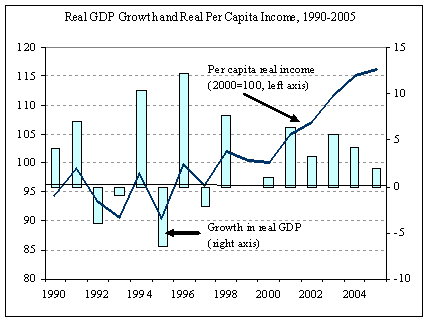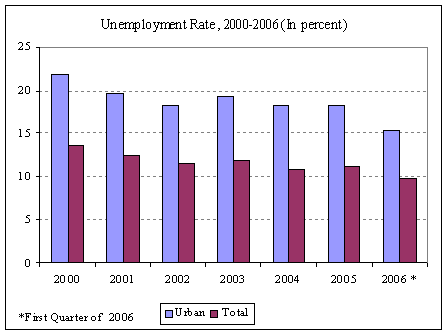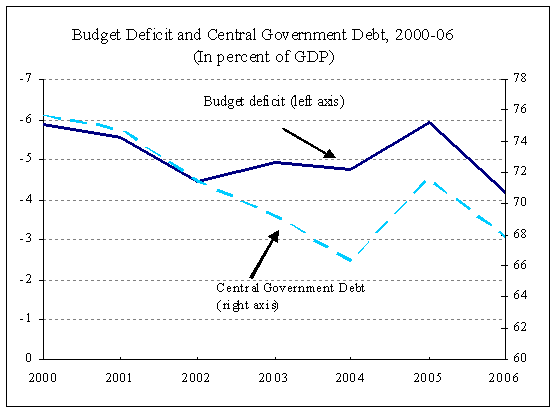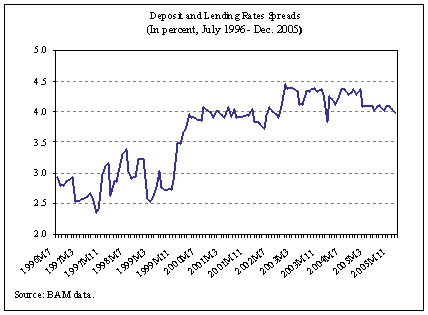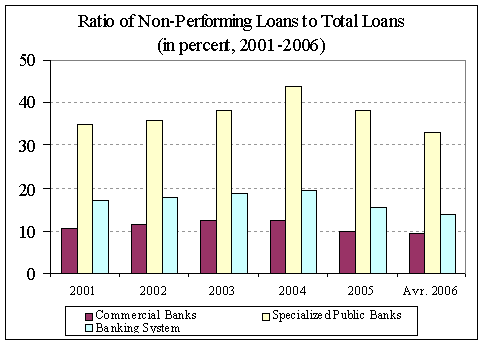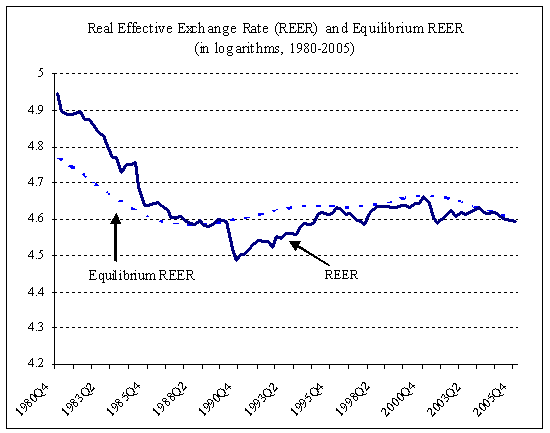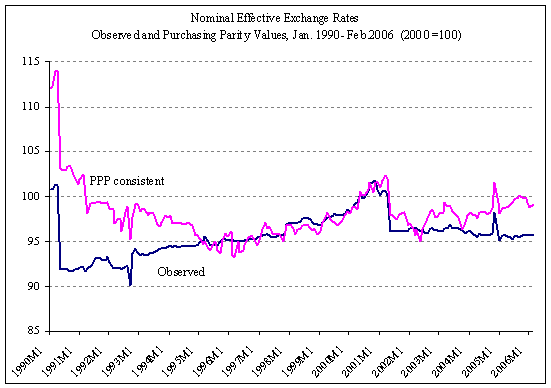Morocco -- Concluding Statement of the Article IV Consultation mission
June 20, 2006
Describes the preliminary findings of IMF staff at the conclusion of certain missions (official staff visits, in most cases to member countries). Missions are undertaken as part of regular (usually annual) consultations under Article IV of the IMF's Articles of Agreement, in the context of a request to use IMF resources (borrow from the IMF), as part of discussions of staff monitored programs, and as part of other staff reviews of economic developments.
1. The mission wishes to thank the Moroccan authorities for their warm welcome. The mission held high-quality discussions with the authorities in an excellent collaborative spirit.
2. The ambitious reform program implemented by Morocco over the last decade is beginning to bear fruit. The economy's fundamentals have considerably strengthened, and macroeconomic conditions have remained solid. Furthermore, progress achieved in the area of trade liberalization, the strengthening of the financial sector, and the privatization and liberalization of the telecommunications, energy, and transportation sectors have enhanced the overall productivity of the economy, making it less vulnerable to fluctuations in agricultural production. The economic performance in 2005 attests to this heightened resilience. In spite of three shocks (the decline in agricultural output linked to insufficient rainfall, the dismantling of the Agreement on Textiles and Clothing, and the upsurge in energy cost), the rate of growth in non-agricultural GDP exceeded 5 percent, inflation remained low, and the external position strengthened. After a lengthy stagnation, per-capita income has been growing regularly since the start of the century, and, for the first time in 35 years, the unemployment rate fell below 10 percent threshold during the first quarter of 2006.
3. The challenge for Morocco is to capitalize on these achievements and build an environment conducive to strong, sustainable, and job-creating growth. Indeed, in spite of progress achieved, Morocco's current growth path is insufficient to achieve significant poverty reduction and to reach a new level of development. The current favorable economic environment provides an excellent window of opportunity to accelerate the reform process and deepen Morocco's integration into the world economy.
| Table 1. Morocco: Selected Economic Indicators, 2001-06 (Quota: SDR 588.20 million) (Population: 30.1 million; 2005) (Per capita GDP: US$1,653; 2005) (Poverty rate: 15 percent ; 2004) (Main exports: textiles, phosphates; 2005) | |||||||
| 2001 | 2002 | 2003 | 2004 | 2005 | 2006 | ||
| Prel. | Proj. | ||||||
|
|||||||
Output and Prices |
(Annual percentage change) | ||||||
Real GDP (market prices) |
6.3 | 3.2 | 5.5 | 4.2 | 1.7 | 7.1 | |
Consumer prices (end of period) |
1.7 | 1.4 | 1.8 | 0.5 | 2.1 | 2.5 | |
Consumer prices (period average) |
0.6 | 2.8 | 1.2 | 1.5 | 1.0 | 2.5 | |
Investment and Saving |
(In percent of GDP) | ||||||
Gross capital formation |
22.9 | 22.7 | 24.1 | 25.0 | 25.9 | 25.6 | |
of which: Non-government |
20.0 | 19.9 | 21.4 | 22.4 | 23.4 | 23.1 | |
Gross national savings |
27.6 | 26.8 | 27.7 | 27.0 | 27.9 | 26.9 | |
of which: Non-government |
27.3 | 25.0 | 26.6 | 25.3 | 28.3 | 24.8 | |
Public Finances |
(In percent of GDP) | ||||||
Revenue (including grants) |
25.1 | 25.0 | 24.7 | 25.4 | 27.7 | 26.8 | |
Expenditure 1/ |
31.7 | 29.9 | 30.1 | 30.5 | 34.2 | 30.8 | |
Budget balance (commitment basis) 1/ |
-6.2 | -4.7 | -5.0 | -4.8 | -5.9 | -4.1 | |
Total government debt |
74.8 | 71.4 | 69.2 | 66.3 | 71.6 | 67.9 | |
Monetary Sector |
(Annual percentage change, unless otherwise indicated) | ||||||
Credit to the private sector |
4.0 | 3.8 | 8.3 | 7.2 | 13.1 | 7.0 | |
Base money |
22.7 | 5.0 | 13.6 | 12.1 | 9.2 | 8.2 | |
Broad money |
14.2 | 6.3 | 8.6 | 7.7 | 14.0 | 8.2 | |
Velocity of broad money (level) |
1.17 | 1.14 | 1.11 | 1.09 | 0.99 | 1.00 | |
Three-month treasury bill rate (period average, in percent) |
4.8 | 3.0 | 3.3 | 2.5 | 2.5 | ... | |
External Sector |
(In percent of GDP, unless otherwise indicated) | ||||||
Exports of goods (in US$, percentage change) |
-3.7 | 9.8 | 11.8 | 13.1 | 7.4 | 9.9 | |
Imports of goods (in US$, percentage change) |
-4.6 | 7.2 | 20.1 | 25.2 | 14.2 | 14.0 | |
Merchandise trade balance |
-8.9 | -8.5 | -9.9 | -13.0 | -15.7 | -16.9 | |
Current account balance excluding official transfers |
4.7 | 3.8 | 3.4 | 1.7 | 1.5 | 0.9 | |
Current account balance including official transfers |
4.8 | 4.1 | 3.6 | 1.9 | 2.0 | 1.3 | |
Foreign direct investment |
8.0 | 1.3 | 5.3 | 1.7 | 3.8 | 2.2 | |
Total external debt |
48.0 | 40.1 | 35.1 | 30.8 | 29.0 | 26.4 | |
Gross reserves (in millions of U.S. dollars) |
8,359.9 | 10,008.9 | 13,715.8 | 16,298.2 | 16,080.0 | 18,956.7 | |
In months of next year imports of goods and services |
7.5 | 7.5 | 8.3 | 8.7 | 7.5 | 8.0 | |
In percent of short-term external debt (on remaining maturity basis) |
390.5 | 362.5 | 576.3 | 823.6 | 910.1 | 1,037.6 | |
Memorandum Items: |
|||||||
Nominal GDP (in US$ billions) |
33.9 | 36.1 | 43.8 | 50.0 | 51.6 | ... | |
Unemployment rate (in percent) 2/ |
12.5 | 11.6 | 11.4 | 10.8 | 11.0 | 9.8 | |
Net imports of petroleum products (in millions of US dollars) |
1,282 | 1,167 | 963 | 1,639 | 2,701 | 3,590 | |
Local currency per U.S. dollar (period average) |
11.30 | 11.02 | 9.57 | 8.87 | 8.87 | ... | |
Real effective exchange rate (annual average, percentage change) |
-4.1 | -0.3 | -14.5 | -6.7 | -1.4 | ... | |
Stock market index (MASI) 3/ |
3,807 | 3,179 | 3,944 | 4,522 | 5,539 | 6,681 | |
|
|
||||||
Sources: Moroccan authorities and Fund staff estimates and projections. 1/ Excluding Fonds Hassan II 2/ Data at end March 2006 3/ Date as of June 14, 2006 | |||||||
|
Short-term economic outlook 4. Available economic indicators for the first few months of 2006 confirm that the economic recovery is taking hold. The growth in non-agricultural GDP remains strong, and is expected to exceed 5 percent for the whole year. Favorable weather conditions should lead to a bumper crop. There are signs that private investment is recovering, bearing witness to the buoyancy of the economy. Notwithstanding a slight acceleration in the first quarter of the year, inflationary pressures remain under control, and the increase in the consumer price index should be limited to 2.5 percent over the year. The current account is expected to record a surplus for the sixth straight year, and the import reserves coverage is projected at about 8 months, or more than the total amount of external debt.1 5. Monetary policy has aptly managed the excess liquidity conditions, as evidenced by the absence of price pressures. The new statutes of Bank Al-Maghrib (BAM), promulgated in early 2006, institutionalize its independence in the conduct of monetary policy and enshrine price stability as its core mandate. In this context, BAM has continued to strengthen the operational framework of monetary policy, particularly by incorporating repos into its policy toolkit in addition to building a government securities portfolio following the Treasury's decision to repay its standard advances (avances conventionnelles). BAM's decision in May 2006 to favor 7-day auctions to mop up excess liquidity has heightened the transparency of monetary policy. The decision to publish a press release upon completion of Central Bank board meetings has likewise enhanced the transparency of BAM's actions and helped to better anchor inflationary expectations. In this context, the signal sent to economic agents at the end of the April Board meeting was appropriate. The upswing in domestic demand does not appear to have generated inflationary pressures. However, the mission shares BAM's concern to remain vigilant in the face of short-term developments, particularly to ensure that excess liquidity does not lead to increased price pressures. 6. Fiscal policy has had to cope with pressures stemming from rising oil prices, and to a lesser extent, sugar prices. After the excellent results recorded in 2005, the consistently good performance of tax revenue during the early months of the year should help keep the deficit in line with the budget law target. In contrast, the contribution of privatization revenues to the financing of the fiscal deficit should play a less prominent role than in the past. 7. In the absence of major macroeconomic risks, the discussions focused on three areas of reform which may help foster an environment conducive to strong job-creating growth: (a) achieving fiscal consolidation; (b) enhancing the efficiency of financial intermediation; and (c) integrating the Moroccan economy into the global economy. Fiscal consolidation 8. The authorities should take advantage of the favorable economic environment to pursue a more rapid pace of fiscal consolidation, which remains a key objective to support strong and sustainable growth. A sounder fiscal position will make it possible to: (i) strengthen private sector confidence; (ii) create the necessary fiscal space for public expenditures needed to support the structural transformation of the economy; and (iii) cushion the impact of exogenous shocks. 9. Recent fiscal consolidation efforts have had a significant impact, as evidenced by the downward trend in the stock of public debt. In 2005, this trend halted on account of the financing of the voluntary retirement program (DVR) and the recognition of the government's liabilities to the pension fund for public employees (Caisse Marocaine de Retraites, CMR). Although they raised both the budget deficit and the debt, these operations are expected to foster fiscal consolidation in the medium term. In 2006, the stock of public debt is expected to decline significantly, thereby resuming its downward trend. 10. The short-term budget outlook is encouraging, but also points to a number of weaknesses.
11. The authorities and the mission are of the view that the existing weaknesses in fiscal policy must be addressed in order to strengthen the credibility of the fiscal consolidation strategy.
12. The mission welcomes the government's efforts to improve the quality of public spending. The implementation of a medium-term expenditure framework and the adoption of performance-based budgeting should enhance the transparency as well as the flexibility of fiscal policy. In addition, the introduction of a modern human resources management framework and the harmonization of the civil service statutes will enhance the efficiency of the civil service. 13. The government and the mission agree that the favorable tax revenue performance reflects both the growing dynamism of the economy and the increased efficiency of the tax administration, and should not slow down the tax reform currently underway. Tax reform is a necessity in Morocco not only because of existing budget pressures, but also to limit the distortions created by a complex tax system, enhance the transparency of tax policy and the credibility of the fiscal consolidation strategy, and improve the business climate. The authorities have taken several steps in this direction: (i) publication of a report on tax expenditures with the 2006 budget law; (ii) preparation of a VAT reform plan aimed at simplifying the rates structure, partly incorporated in the 2006 budget law; and (iii) publication of a tax procedures handbook, as well as a tax assessment and collection handbook. These efforts are a good starting point, and should be vigorously pursued. 14. The authorities should seize the opportunity afforded by the 2007 budget law to send a strong signal regarding their determination to achieve their medium-term fiscal consolidation objectives. In particular, it will be important to: (i) continue securing substantial savings on the wage bill; (ii) reduce subsidy expenditures; and (iii) maintain the favorable performance of tax revenue. These measures should make it possible to reduce the deficit to around 3.5 percent of GDP in 2007, and help bring the public debt down below 60 percent of GDP in the medium term. Enhancing financial intermediation
15. Because it ensures that available resources can be allocated to wealth-creating sectors, efficient financial intermediation is an important prerequisite for strong and sustainable growth. The current situation in Morocco is characterized both by a very liquid banking sector, and an insufficient access by firms, particularly the smallest of them, to bank financing. The essentially external origin of the liquidity overhang in the banking system partly accounts for the difficulties encountered by the Moroccan economy in absorbing this liquidity. The recent upsurge in certain types of credits—particularly in real estate credit—is a welcome sign that this absorption capacity is improving. However, the spread between banks' lending and borrowing rates remains relatively high, underscoring the need to strengthen the efficiency of financial intermediation mechanisms. The lack of adequate data on the evolution of the cost of credit makes it difficult, however, to assess the magnitude of this problem with precision.3 BAM's efforts to measure the changes in credit conditions by surveying banks will make it possible to fine-tune this assessment in the coming months. 16. The mission discussed the key steps taken by the Moroccan authorities to improve access to credit and the terms of financing for enterprises, particularly small and medium enterprises (SMEs) and micro-enterprises. Discussions focused on three main issues:
The mission encouraged the authorities to pursue their discussions to improve the mobilization of institutional savings, specifically in order to lengthen the maturity of the resources available for the financing of the economy. The mission welcomes the near completion of a study on this topic carried out with the European Investment Bank. Morocco's integration into the global economy 17. Morocco's successful integration into the global economy has a key role to play to accelerate growth. Three issues are of particular importance in this respect: (i) enabling the economy to better adapt to the challenges of globalization by enhancing productivity and investment; (ii) pursuing trade liberalization efforts; and (iii) preparing a gradual transition to an exchange rate regime more closely determined by market forces. Enabling the economy to better adapt to the challenges of globalization 18. The strengthening of infrastructure—particularly for highways and ports—and liberalization efforts in the electricity, transport, and telecommunications sectors are expected to generate substantial productivity gains for the economy as a whole. The implementation of the Plan Azur for tourism has strengthened the supply side of the sector. Furthermore, the Plan Emergence, prepared at end-2005, encompasses two main areas: (i) modernizing and strengthening the existing industrial sectors, notably to limit the impact of the dismantling of the Agreement on Textiles and Clothing on the textile sector; and (ii) supporting and facilitating the emergence of new sectors such as electronic components, outsourcing of automobile manufacturing, and aeronautic industry, as well as service activities, particularly those related to offshoring. The authorities have implemented a broad range of incentives, including tax incentives, subsidies for training activities to develop the required skills and competencies, and developed and outfitted four offshore zones. Although these measures have already borne fruit, it is important to ensure that this proactive approach does not further complicate the tax system, create distortions and eventually lead to a two-track economy. Pursuing trade liberalization efforts 19. Trade liberalization is progressing, particularly through the Association Agreement with the EU. Liberalization efforts intensified in 2005 with the signing (in the context of the Euromed process) of the Agadir agreement with Tunisia, Egypt, and Jordan. This agreement allows for cross rules of origin among the four partners vis-à-vis the EU. This agreement should be implemented expeditiously. At the same time, bilateral free-trade agreements with Turkey and the USA entered into force on January 1, 2006. Bilateral and regional liberalization efforts should, however, be supported by further multilateral liberalization to minimize the risk of trade diversion. Emphasis should also be placed on liberalizing services. Morocco has made significant progress in this direction by submitting a proposal to this effect to the World Trade Organization, and by participating in the launching of the framework protocol for the liberalization of services within Euromed in the wake of the March 2006 Marrakesh meeting. 20. These trade liberalization endeavors should be complemented by measures to facilitate trade and reduce non-tariff barriers. The streamlining of customs procedures has already allowed for a significant reduction in customs processing times. Furthermore, since the November 2005 Algiers conference on trade facilitation in the Maghreb, an action plan to facilitate payment arrangements, combat smuggling, and harmonize trade regulations and rules of origin on a region-wide scale should be approved in 2006. The regional conference on financial integration in the Maghreb, to be held in Rabat in November 2006, will complement these efforts. To align market conditions with those prevailing in the EU and comply with EU requirements, the authorities have also adopted legislation on the recognition of norms, industrial property, and consumer protection. Transition to a new exchange rate regime 21. The mission considers that the existing currency-basket peg of the dirham as well as the current level of the exchange rate for the dirham, remain appropriate. Nonetheless, the mission welcomes authorities' intention to prepare for the eventual transition to a more flexible exchange rate. In fact, an exchange rate that reflects market forces would allow Morocco to derive greater benefit from its growing integration into the world economy. However, adopting such a regime will require substantial progress in the implementation of several reforms already initiated by the authorities:
Other 22. The mission welcomes Morocco's subscription to the IMF's Special Data Dissemination Standard. It also applauds progress achieved in consolidating the public accounts. Finally, the mission encourages the authorities to start preparing for the transition to the compilation of public accounts according to the IMF's 2001 Government Financial Statistics Manual methodology. 23. Lastly, the mission commends the government for its decision to publish the concluding statement of the Article IV consultation mission on the websites of the Ministry of Finance and Privatization, Bank Al-Maghrib, and the IMF.
1 The import reserves coverage is calculated on the basis of projected official reserves at end-2006 and projected imports of goods and non-factor services in 2007. 2 The concept of budget deficit used in this document reflects the accrual basis for recording the deficit, exclusive of privatization revenues and operations conducted through the Hassan II Fund for economic and social development. 3 In particular, the cost of credit is currently captured using the weighted average rate (TMP) of banks, i.e., the ratio of the yield of existing credits to their stock. During periods of steady decline in interest rates, this method biases upward the measurement of lending terms for new credits. | ||||||||||||||||||||||||||||||||||||||||||||||||||||||||||||||||||||||||||||||||||||||||||||||||||||||||||||||||||||||||||||||||||||||||||||||||||||||||||||||||||||||||||||||||||||||||||||||||||||||||||||||||||||||||||||||||||||||||||||||||||||||||||||||||||||||||||||||||||||||||||||||||||||||||||||||||||||||||||||||||||||||||||||||||||||||||||||||||||||||||||||||||||||||||||||||
IMF EXTERNAL RELATIONS DEPARTMENT
| Public Affairs | Media Relations | |||
|---|---|---|---|---|
| E-mail: | publicaffairs@imf.org | E-mail: | media@imf.org | |
| Fax: | 202-623-6220 | Phone: | 202-623-7100 | |








